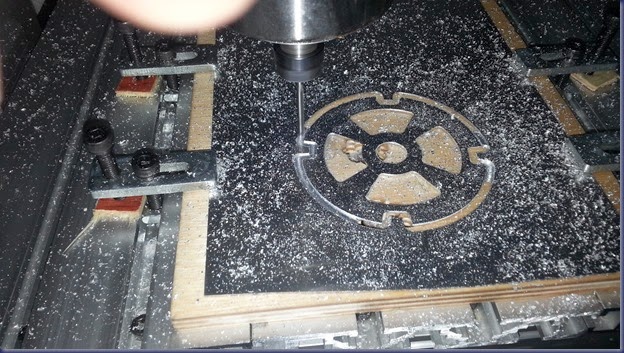The conical clock fully functional!

Images tell more than million words 
- New pendulum support arc design: more stable and stronger
- New bevel gear design: Allows more play and wood imperfections, runs smoother than the original design
- Speed control plate
- Elliptical clock dial
- Elliptical clock hands
Still missing:
- Lower decorative arc
- wheel stoppers
- wood finishing
- brass pendulum polishing
I am really proud and happy with this project and I imagine the Clyton Boyer will enjoy the implementation of his basic idea that was draft paper few months ago. I hope I was able to intemperate and visualize his concept by making it a real clock using a new driving technology. As far as I know this is the first Conical Wooden Clock!
In few days I will go back to the hospital for a second surgery (this one is to bring me back to normal conditions by removing an ostomy bag and fix some abdominal issues) so I will be out of my garage for some time.
Update 4/18/2014:
Clyton Boyer email:
After Clyton saw this post he wrote to me:
“…SO Excellent, Carlos. Yes, I believe it is the only wooden conical also. I have seen a lot of conicals, and I've been to many clock museums or museums with clocks, and I've never seen my dream of a wooden conical realized...until NOW! and I love it. I am so happy that you took on this design and added your ingenuity to it and helped to create my dream (and apparently YOUR dream, as well).
I really like the way it looks and all of the personalizations that you have added to it, like the oval dial, the bevel gears, and many other smaller changes (and of course, your very own self-created motor!!! That's no small task!)
The conical design really looks so beautiful and there is so much action. I truly appreciate your dedication and what you have done to create the conical in real life. It's a beauty.
Good luck with your second surgery. Hopefully all goes very well and you will be up and back in the shop very soon.
Thanks for keeping me informed on your project. It is so much fun!…”
And in a previous mail when I was sharing with him the first tests he wrote:
“…The motor-driven conical pendulum clock that you have built is truly wonderful. I showed all the vids to my wife. She has given you build a "Two Thumbs Up!" approval, and thinks it looks "really neat!"
I have to agree. I've always liked that design, and have always been tempted to build it, but now that I see it in action, I'm even more motivated. I'm glad it worked well with the motor you designed to drive it. I would, of course, drive mine with rocks...paleolithic style. Ha. Or this might also be a nice constant force spring-driven design in a tabletop version. But as you mention, conical pendulums have an inherently inaccuracy in their design, and none would be anywhere near as accurate as your motor driven version.
It is SO lovely to see a vision that I only had in my head come to life! Thank you for your passion on this project. It is wonderful to share with other builders that share the same passions.
Beautifully done, Carlos!!!…”
I only have to say to Clyton:
Thank you very much for introducing me to this amazing hobby! This has been the most amazing and pleasure providing creative activity I have ever performed. My brain is exploding with ideas and new projects. I never thought that there were so many artistic and creative neurons active in my brain.
this beautiful mini lathe that at the time was on offer for an incredible low price



































